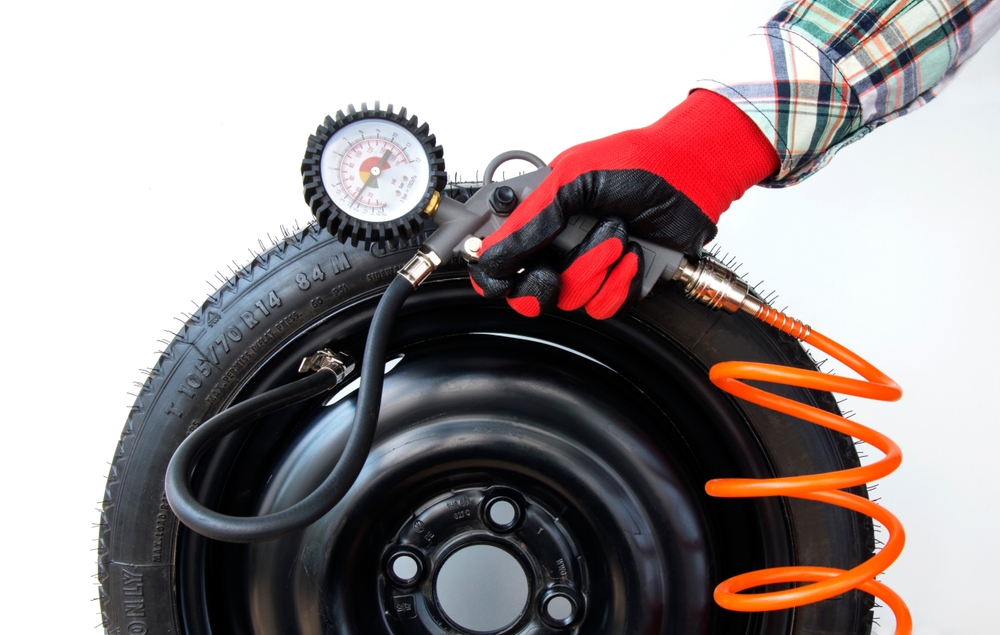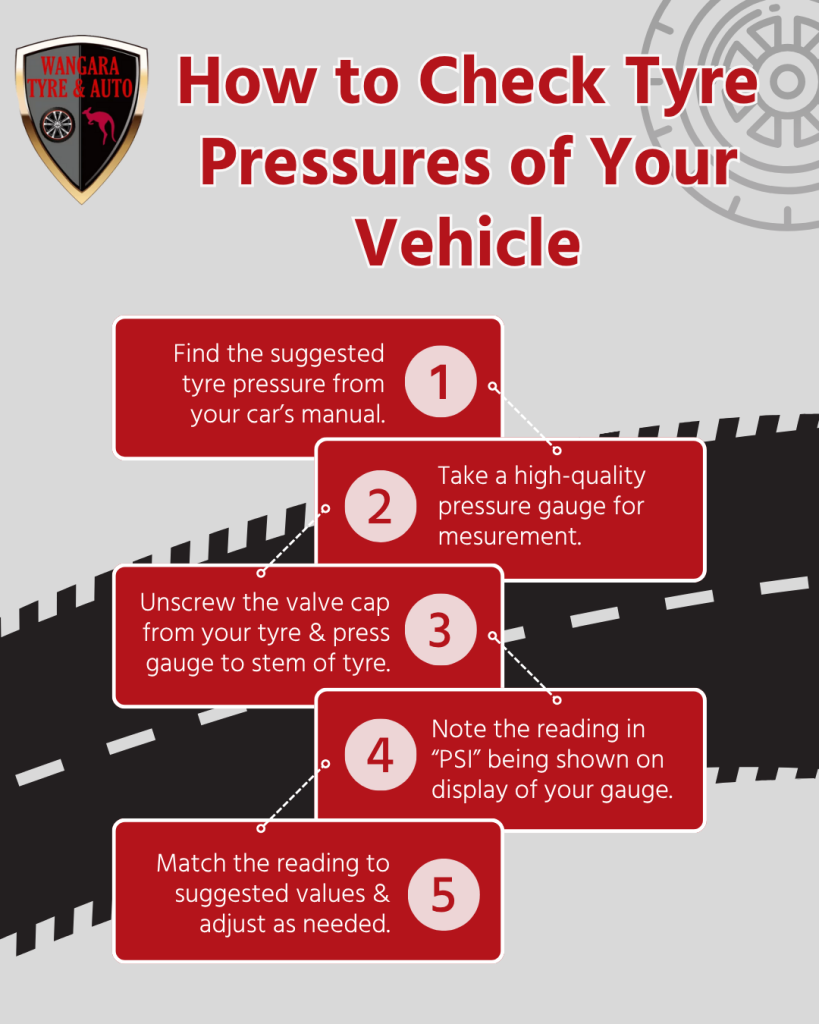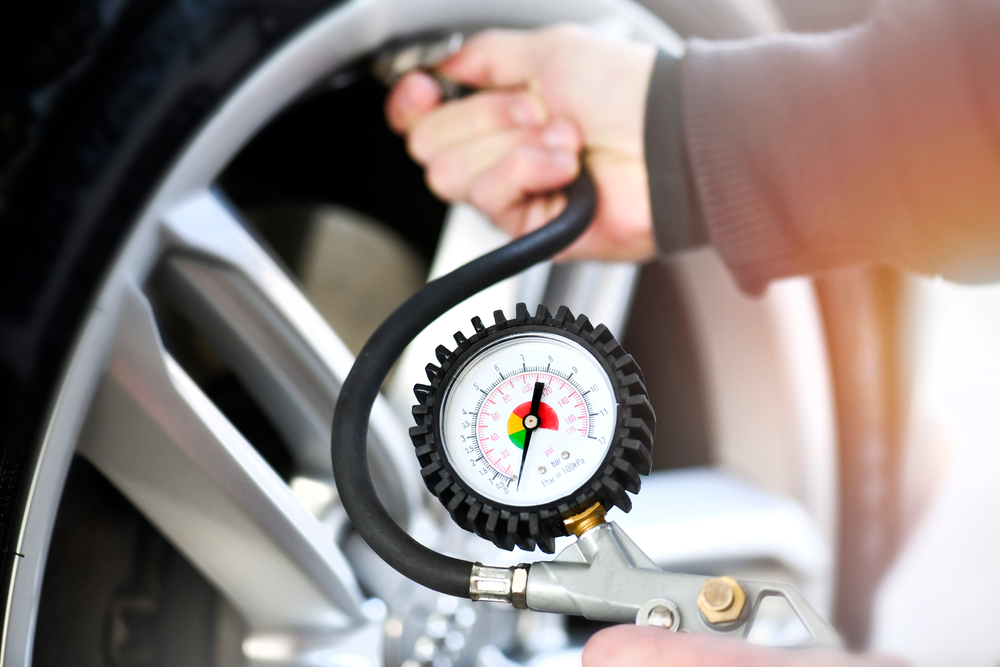Do You Check Your Tyre Pressures Correctly? Drivers’ Guide

Is your car not handling right? or are you visiting the petrol station more than usual?
In most of cases, the root cause of that is simpler than you think, your tyre pressures. If too low or too high, they can mess with your fuel efficiency, vehicle handling, and even your safety on the road.
Not sure about the correct pressure for your vehicle? Or don’t know how to check the tyre pressure?
Don’t worry. Wangara Tyre Auto, with the experience of more than decade in tyre fitting & servicing, can help you. If you are a driver in Perth and want to keep your tyres safe, healthy & long-lasting, this guide is for you.
What is Car Tyre Pressure and How It’s Measured in Australia?
Tyre pressure refers to how much air is inside your tyres.
If there’s too little, the tyre becomes soft and more of it touches the road. So, it wears downs quickly and doesn’t last for long time. If there’s too much pressure, the tyre becomes hard and bouncy and become more likely to slide or burst.
In Australia, tyre air pressure is measured in PSI, short for pounds per square inch.
It’s a common unit that’s easy to read with most air pumps and gauges. When you hear someone mention tyre psi pressure, that’s what they’re talking about. Every car has its own ideal range, and staying within that helps with grip, fuel use, and tyre lifespan.
Now let’s find out how to check that range for your car & match the tyre pressure with it.
How to Check Your Tyre Pressures at Home
Here are the steps you need to take for accurate tyre pressure measurement & adjusting it to optimal levels.
1. Find Out the Right Tyre Pressures for Your Car
The first step is knowing what the tyre pressure should be for your vehicle.
This number isn’t the same for every car. Lighter cars need less air; heavier ones or those carrying big loads may need more. Usually, there’s one pressure for the front tyres and a slightly different one for the back.
You can find this information in your car’s manual or printed near the driver’s seat. Stick with that range. Remember that you can’t decide your tyre pressure by guessing what feels right. Only the amount suggested by manufacturer will work to get your tyres work properly.
2. Check Tyre Pressure Using a Gauge
Once you know the numbers, the next step is to physically check your tyre pressures. Don’t rely on looks, many under-inflated tyres look perfectly fine. Use a gauge, either digital or analogue, to get an accurate reading.
- Start by making sure the tyres are cool.
- Unscrew the valve cap from the tyre of your vehicle (one at a time).
- Press the gauge firmly onto the valve stem of tyre.
- Check the tyre psi pressure reading being shown on gauge and write it down.
Check for all the tyres one by one. If you’re carrying a spare, give that a check too. Spare is easy to forget but important when emergencies hit.
3. Add or Release Air to Match the Right Pressure
Once you’ve got your tyre pressure readings, compare them to the suggested levels found in manual. If they’re lower, add air using a compressor. If they’re higher, press on the valve to let some air out and then check again.
Local petrol stations also have air stations with easy settings. You can enter the PSI you need, and the machine stops when it’s done. If you’d prefer, we at Wangara Tyre Auto can also do it for you and give you a quick tyre health check.
Wondering what’s the need for it? Let’s discuss it in detail.
Why You Should Check Tyre Pressure Regularly
Driving with the right wheel pressure makes your car safer, cheaper to run, and easier to control. Regular pressure checks:
Keeps You Safe:
Tyres grip the road better when properly inflated. This helps when you need to brake quickly or steer around a hazard.
Saves Fuel:
Soft tyres make your engine work harder and need more fuel. Keeping them properly inflated cuts down on fuel usage.
Lasts Longer:
With the right pressure, only the required area will touch the road. So, it leads to even tyre wear & your tyres won’t need replacing as often.
Makes Handling Better:
Your car rides more smoothly and responds quicker to the wheel when the tyres are at the right pressure.
Keep in mind that not only under-pressure or overpressure affects your vehicle safety. But, small differences in tyre psi can also change how your car behaves on the road.
What Affects Tyre Pressure Without You Realising?
Most people ignore the pressure checks because their tyres are safe and sound. But punctures are not the only cause of your tyres losing air. There are several other sneaky ways your tyre pressures can shift without warning. E.g.
Factor | How It Affects Tyre Pressure |
Cold Weather | Air contracts in colder temperatures, causing pressure to drop even if there’s no actual leak. |
Heat from Driving | Long drives warm up the tyres, which temporarily increases the pressure inside. |
Heavy Loads | Carrying more weight puts extra stress on tyres, and require a slight pressure increase. |
Tyre Condition | Older or worn-out tyres naturally lose air over time through slow leaks. |
Type of Terrain | Rough or muddy surfaces force tyres to work harder and result in pressure loss. |
These changes happen gradually, which is why checking once a month keeps things in check.
Adjusting Tyre Pressures for Different Driving Conditions
Sometimes, the normal setting isn’t quite right for special situations, like difficult terrain or extra load. Here are some situations when you need to adjust your tyre pressures.
- High-Speed Driving: Slightly more pressure helps tyres stay cool on long road trips.
- Heavy Loads: If you’re packing the car full of gear or people, increase the pressure a bit to handle the extra weight.
- Off-Roading: When you’re tackling dirt or sand, slightly lower the pressure to improve grip. Just remember to re-inflate before hitting paved roads.
- Rainy Days: Having the correct tyre psi helps water clear out from under the tyres, and reduces the chance of slipping.
While making these adjustments, make sure you stay within the safe pressure limits printed on the tyre itself. So, no damage is caused to the tyre health.
5 Simple Tips to Keep Your Tyres in Good Shape
Caring for your tyres doesn’t take much effort. But it can avoid major tyre problems and give you a smoother & safer driving. Some important care tips are given below.
- Check the tyre pressure every month no matter how less you drove. Make it part of your routine, it only takes a few minutes.
- Inspect the tyre condition and pressure before any long trip. Especially when carrying more weight or going off-road.
- Use a high-quality tyre psi gauge and keep it with you in the glove box just in case.
- Look for uneven tyre wear. It can be a sign that something’s off with the pressure or alignment.
- Get it checked from experts after an interval to make sure your gauge is measuring correctly and you’re doing it correctly.
Need Help with Tyre Pressure or Expert Advice?
Come See Us at Wangara Tyre Auto
Our team at Wangara Tyre Auto has been helping local drivers stay road-safe for over a decade. We supply tyres for all types of vehicles – from everyday sedans to adventure-ready 4x4s.
Not sure what your tyre pressure should be for your next trip?
Drop in anytime for a chat. We’ll check your tyres condition and pressure. Make or suggest the needed adjustments. And get you back on the road quickly.
FAQs
Q1: How can I tell if my tyres are under-inflated?
Look out for poor steering, extra fuel use, or tyres that feel soft when pressed. Confirm it by checking tyre pressure with the help of a gauge.
Q2: Should all tyres be at the same PSI?
Not always. Some cars have different pressure requirements for front and rear tyres.
Q3: How often do tyres lose pressure?
Tyres can lose a small amount of air every month, even more in cold weather. Driving conditions and loading can also affect this amount.
Q4: What’s the best time to check tyre pressure?
Check the pressure when tyres are cold. It can be in the morning before driving or after the car’s been parked in shade for a while.
Q5: Can too much pressure cause damage?
Yes. Over-inflated tyres wear unevenly and can slide on road. They also can burst more easily if you hit a pothole.


